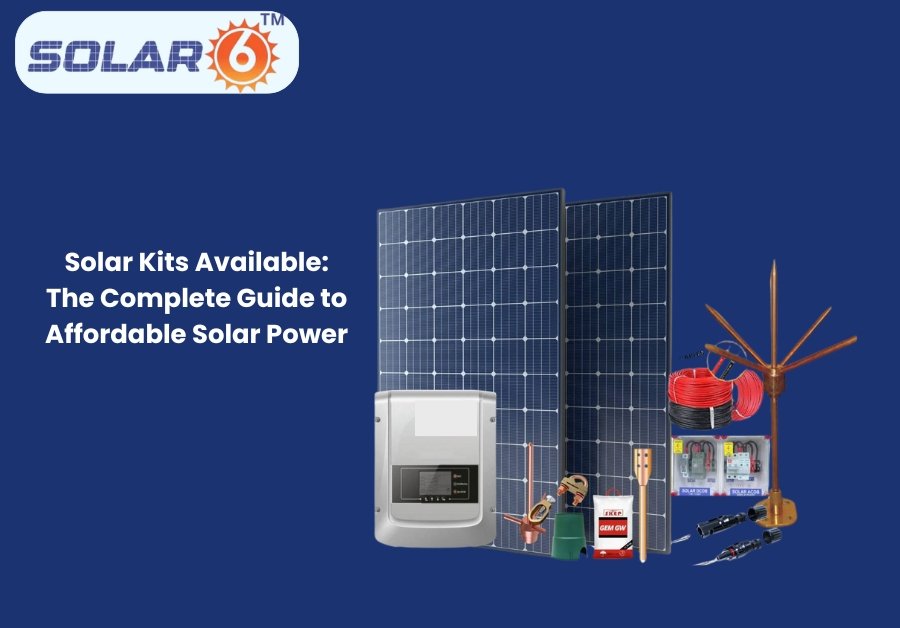Introduction
As electricity prices continue to climb and the need for sustainable energy grows, more homeowners and small businesses are turning to solar energy. One of the easiest ways to go solar today is through solar kits, complete, ready-to-install packages that include everything you need to start generating your own electricity.
Solar kits are designed for simplicity, efficiency, and affordability. They eliminate the hassle of sourcing components individually and make solar energy accessible to anyone, whether you live in a city apartment or a rural home. With government incentives, improved solar technology, and trusted providers like Solar6, solar kits are revolutionizing how people access clean, renewable power.
What Are Solar Kits?
A solar kit is a bundled package that includes all the essential components required to set up a solar power system. Instead of buying each part separately, solar panels, inverter, cables, mounting structure, and battery, everything is pre-selected and delivered as one unit.
These kits are ideal for homes, offices, small shops, and even farms. They are designed to ensure all parts are compatible, making installation faster and more efficient. Some kits are even “plug-and-play,” requiring minimal technical knowledge.
A typical solar kit contains:
- Solar Panels: Convert sunlight into DC electricity.
- Inverter: Converts DC power into AC electricity suitable for household use.
- Mounting Structures: Secure the panels on rooftops or open areas.
- Cables and Connectors: Ensure proper and safe electrical flow.
- Batteries (optional): Store energy for later use, useful in off-grid areas.
- Protection Devices: Include earthing kits, fuses, and surge protectors for safety.
Types of Solar Kits
Different types of solar kits are available depending on your energy needs and grid connection. Let’s look at the main types:
1. On-Grid Solar Kits
On-grid systems are connected to the main electricity grid. They generate power during the day, and any excess energy is exported to the grid through net-metering. These kits are ideal for areas with a stable electricity supply and help reduce monthly power bills.
2. Off-Grid Solar Kits
Off-grid kits operate independently of the main grid. They include batteries to store electricity for nighttime use or during power cuts. These systems are perfect for remote areas where grid electricity is unavailable or unreliable.
3. Hybrid Solar Kits
Hybrid systems combine the best of both worlds; they connect to the grid and include batteries. This means you can use solar energy during the day, export excess power, and rely on battery backup when needed. Though more expensive, hybrid systems offer unmatched flexibility.
4. Portable Solar Kits
Portable kits are compact, lightweight, and easy to install. They are ideal for camping, small cabins, or temporary setups. They provide enough energy to power basic appliances and lights, and are a great way to start exploring solar energy.
Why Choose a Solar Kit?
Solar kits are growing in popularity for several reasons. They are cost-effective, convenient, and environmentally friendly. Here are the major benefits:
1. Easy Installation
Since the components are pre-matched, installation becomes simpler and faster. Many kits can be installed in a single day by trained technicians.
2. Cost-Effective Solution
Buying a complete package often costs less than purchasing individual components. You also save money on design and compatibility checks.
3. Reliable Performance
The components in a kit are selected to work efficiently together, ensuring steady and dependable energy output.
4. Scalable Options
You can start with a smaller capacity kit, like 1kW, and later expand to 3kW or 5kW as your energy needs grow.
5. Low Maintenance
Solar kits are designed for minimal upkeep. Regular cleaning of the panels and periodic inspection of the system are usually enough.
6. Environmentally Friendly
Every kilowatt of solar energy produced helps reduce greenhouse gas emissions and supports India’s clean energy mission.
Understanding the Components of a Solar Kit
Let’s explore the main components in more detail so you can make informed decisions:
1. Solar Panels
Panels are the most critical part of a solar system. Modern panels use high-efficiency technologies like monocrystalline or bifacial designs, ensuring better power generation even in low sunlight conditions.
2. Inverter
The inverter converts the DC electricity produced by solar panels into AC power that can run your household appliances. On-grid systems use grid-tied inverters, while off-grid systems use hybrid or standalone inverters.
3. Mounting Structure
These sturdy frames hold the panels securely on your rooftop or the ground. They are made from corrosion-resistant materials and designed to withstand wind and weather.
4. Batteries
Off-grid and hybrid systems use batteries to store surplus power. Lithium-ion batteries are now the preferred choice because they are compact, efficient, and long-lasting.
5. Cabling and Protection
Cables, connectors, and earthing kits ensure your system operates safely. Proper wiring reduces power loss and increases overall efficiency.
How to Choose the Right Solar Kit
Selecting the right solar kit depends on your power needs, roof space, and budget. Here’s a simple checklist to guide you:
A. Assess Your Energy Consumption
Look at your monthly electricity bill to understand your average usage. A 1kW system typically generates around 4 units of power per day, so you can estimate how much capacity you need.
B. Check Roof Space and Orientation
Ensure your roof has enough space and proper orientation for sunlight exposure. South-facing rooftops are ideal for maximum energy generation in India.
C. Decide on System Type
- Go on-grid if you have reliable electricity and want to lower bills.
- Choose off-grid if you face frequent power cuts or live in remote areas.
- Opt for a hybrid if you want both grid connection and battery backup.
D. Evaluate Quality and Warranty
Choose a kit from a trusted provider with certified components. Look for panels with at least 25 years of performance warranty and inverters with 5–10 years warranty.
E. Understand Subsidy and Financial Options
The Indian government offers attractive subsidies for residential rooftop solar installations under various schemes. You can also explore solar loans or EMI options to make the investment easier.
F. Installation and After-Sales Service
Select a company that provides professional installation, monitoring, and maintenance support. Reliable after-sales service ensures your system performs efficiently for years.
Challenges and Considerations
While solar kits offer immense benefits, there are a few challenges to consider:
- Initial Cost: The upfront investment can be high, though subsidies and EMI options make it manageable.
- Roof Strength: Old or weak rooftops may need reinforcement.
- Weather and Dust: In dusty regions, frequent cleaning is necessary for optimal performance.
- Battery Maintenance: Off-grid systems require periodic battery checks and replacements after several years.
These challenges are minor compared to the long-term benefits, especially when you choose quality products and professional installation.
Future of Solar Kits in India
The solar energy market in India is rapidly expanding, and solar kits are at the forefront of this transformation. Future trends include:
- Advanced high-efficiency panels that generate more power in less space.
- Smart monitoring systems for real-time tracking of energy production.
- Affordable hybrid kits as battery costs continue to fall.
- Government-backed programs promoting residential rooftop installations.
- Increased online availability of ready-to-install kits for faster adoption.
With innovation and awareness growing, solar kits are set to become as common as household appliances in the near future.
Conclusion
Solar kits are simplifying the way India adopts solar power. They provide everything needed for a complete solar setup, from panels and inverters to mounting and wiring, all in one package. Whether you want to reduce electricity bills, gain energy independence, or contribute to a cleaner planet, solar kits make it possible.
With trusted providers like Solar6, transitioning to renewable energy has never been easier. From helping you select the right system to professional installation and long-term service, Solar6 ensures that your journey toward sustainability is smooth, reliable, and rewarding.
Harness the power of the sun today. Your energy independence starts with a solar kit!

